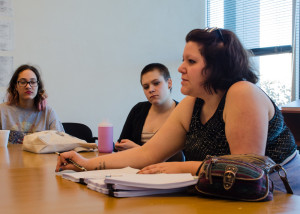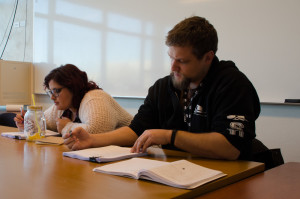Tags
Related Posts
Share This
Glyph 2016
“A lot less God this year, but a lot more water,” says Melinda Freudenberger, second term Glyph editor and head editor for the 2016 edition in reference to the thematic resonance of this year’s annual campus literary journal, Glyph. Production for the 2016 edition is coming to a close.

Head editor Melinda Freudenberger addresses the Glyph staff. Photo by Rebeca Gonzalez
“It’s a super collaborative process,”Freudenberger says, “a lot of logistics, a lot of details.” The creation starts, of course, with the enormous pile of student submissions, 500 pages of poetry, nonfiction and fiction, being poured over by five student editors and Faculty Advisor Anne Valente. The voting stage is next, when pieces are chosen by the staff in a majority vote. The pieces that survive the voting stage are passed back to the original authors for revisions. With the refined works returned, the manuscript is sequenced; this process is organic and filled with many “spirited debates” about each piece’s place in the long line of pieces.
With these first stages complete, the Glyph staff has now moved on to the proofreading portion, in which they begin to look through the entire manuscript for small edits and changes. “There’s tremendous value in having a campus publication…I think it’s really beneficial for everyone to have the opportunity to determine what it is to put together a literary journal. How are pieces selected? How is the journal produced?” says Valente. “Even if someone here never serves as an editor, I think it’s really important just to have the chance to read each other’s work critically.”
When proofreading ends, the editors will hand the project off to Glyph’s graphic designer, Caleb Ortega. Ortega emphasized a desire to first and foremost “honor the tradition of keeping [this] awesome collection of work beautiful.” He articulated a good grasp on literary forms as well, understanding the importance of making the graphic layout “adhere to the genre styles” specifically by allowing page space for poetry, and keeping section breaks in prose. Ortega was enthusiastic about the project, saying he wants to make Glyph 2016 “really sophisticated and really clean.”

Editors Andrew Koss and Amaya Garza examine the Glyph manuscript. Photo by Rebeca Gonzalez
As they enter the final stages, the staff spoke about the book starting to mysteriously resonate thematically. “I’ve never believed in the collective unconscious before but…doing last year’s Glyph there was this overwhelming theme of space, empty spaces, like oceans or literally outer space and…a lot of questions about God,” Freudenberger says. “In this Glyph I see more topics approaching the feminist realm…a lot of pieces on women’s bodies and the power they have…A lot less God this year, but a lot more water…It’s really confounding to me. All of this work comes from a really personal place, and so it’s interesting to see [them]…relating in a really communal way. I think it’s my favorite part.”
Brianna Neumann, Glyph Editor in her first term, had a similar response to universal themes, noting, “I’m a big fan of art as a time capsule. [Glyph] is a good way of encapsulating what [the community] was thinking and feeling at that time.” This speaks to the benefits of the journal beyond the technical aspects of production. “The Glyph process is really about looking at what our school is writing as a whole. Which, I think, is something we don’t do a lot.” Neumann says. “[Glyph] really builds a community…this represents us.”
Glyph 2016 will be released during the Glyph Gala on May 3.






 Jackalope Magazine is the student magazine of Santa Fe University of Art and Design. Building on the interdisciplinary nature of our education, we aim to showcase the talent of our university and character of our city.
Jackalope Magazine is the student magazine of Santa Fe University of Art and Design. Building on the interdisciplinary nature of our education, we aim to showcase the talent of our university and character of our city.
Recent Comments